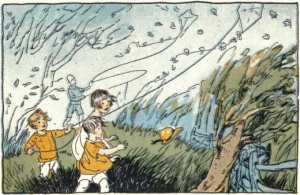You are using an out of date browser. It may not display this or other websites correctly.
You should upgrade or use an alternative browser.
You should upgrade or use an alternative browser.
Marching Into March
- Thread starter Meanderer
- Start date
16 Surprising Facts About the Month of March (LINK)
The month of March isn't just about celebrating St. Patrick's Day and the start of spring.

1. It’s March—Happy New Year, ancient Romans!
"Welcome to the third month of the year—or, if you were born before 150 B.C., the first! According to the oldest Roman calendars, one year was ten months long, beginning in March and ending in December. It may sound crazy, but you can still see traces of this old system in our modern calendar: because December was the tenth month, it was named for the number ten in Latin (decem), just like September was named for seven (septem). So, what about January and February? They were just two nameless months called “winter,” proving that winter is literally so awful it doesn’t even deserve a spot on the calendar. Check out these vintage photos that prove winter was way worse in the past."
https://www.rd.com/culture/month-of-march-facts/
The month of March isn't just about celebrating St. Patrick's Day and the start of spring.

1. It’s March—Happy New Year, ancient Romans!
"Welcome to the third month of the year—or, if you were born before 150 B.C., the first! According to the oldest Roman calendars, one year was ten months long, beginning in March and ending in December. It may sound crazy, but you can still see traces of this old system in our modern calendar: because December was the tenth month, it was named for the number ten in Latin (decem), just like September was named for seven (septem). So, what about January and February? They were just two nameless months called “winter,” proving that winter is literally so awful it doesn’t even deserve a spot on the calendar. Check out these vintage photos that prove winter was way worse in the past."
https://www.rd.com/culture/month-of-march-facts/
Aunt Bea
SF VIP
- Location
- Near Mount Pilot

This painting by Briton Riviere, a British artist, always reminds me of March and the old saying in like a lion out like a lamb.
The painting depicts Una from the poem, The Faerie Queene by Edmund Spenser. The poem is allegorical about Queen Elizabeth I, who according to the poem trained the lion so well that it doesn't attack the lamb. The lion is thought to represent Queen Elizabeth's power, her elegance and her aristocratic figure.
Pam
Well-known Member
- Location
- Cumbria, England.
Like an army defeated
The snow hath retreated,
And now doth fare ill
On the top of the bare hill;
The Ploughboy is whooping–anon–anon:
There’s joy in the mountains;
There’s life in the fountains;
Small clouds are sailing,
Blue sky prevailing;
The rain is over and gone!
Written in March
by William Wordsworth
The snow hath retreated,
And now doth fare ill
On the top of the bare hill;
The Ploughboy is whooping–anon–anon:
There’s joy in the mountains;
There’s life in the fountains;
Small clouds are sailing,
Blue sky prevailing;
The rain is over and gone!
Written in March
by William Wordsworth
RadishRose
SF VIP
- Location
- Connecticut, USA

Pappy
Living the Dream
RadishRose
SF VIP
- Location
- Connecticut, USA
jujube
SF VIP
In like a lamb, out like a lion. Or maybe not:
Last edited:
Aunt Bea
SF VIP
- Location
- Near Mount Pilot
Pappy
Living the Dream
CatGuy
New Member
- Location
- St. Louis, MO
March is a shameless tease of a month. One day it's beautiful, warm, sunny, a true taste of spring. Two days later, there's a foot of snow on the ground...
Dear March - Come in
Emily Dickinson - 1830-1886
Dear March - Come in -
How glad I am -
I hoped for you before -
Put down your Hat -
You must have walked -
How out of Breath you are -
Dear March, how are you, and the Rest -
Did you leave Nature well -
Oh March, Come right upstairs with me -
I have so much to tell -
I got your Letter, and the Birds -
The Maples never knew that you were coming -
I declare - how Red their Faces grew -
But March, forgive me -
And all those Hills you left for me to Hue -
There was no Purple suitable -
You took it all with you -
Who knocks? That April -
Lock the Door -
I will not be pursued -
He stayed away a Year to call
When I am occupied -
But trifles look so trivial
As soon as you have come
That blame is just as dear as Praise
And Praise as mere as Blame -

Emily Dickinson was born on December 10, 1830, in Amherst, Massachusetts. While she was extremely prolific as a poet and regularly enclosed poems in letters to friends, she was not publicly recognized during her lifetime. She died in Amherst in 1886, and the first volume of her work was published posthumously in 1890.
Emily Dickinson - 1830-1886
Dear March - Come in -
How glad I am -
I hoped for you before -
Put down your Hat -
You must have walked -
How out of Breath you are -
Dear March, how are you, and the Rest -
Did you leave Nature well -
Oh March, Come right upstairs with me -
I have so much to tell -
I got your Letter, and the Birds -
The Maples never knew that you were coming -
I declare - how Red their Faces grew -
But March, forgive me -
And all those Hills you left for me to Hue -
There was no Purple suitable -
You took it all with you -
Who knocks? That April -
Lock the Door -
I will not be pursued -
He stayed away a Year to call
When I am occupied -
But trifles look so trivial
As soon as you have come
That blame is just as dear as Praise
And Praise as mere as Blame -

Emily Dickinson was born on December 10, 1830, in Amherst, Massachusetts. While she was extremely prolific as a poet and regularly enclosed poems in letters to friends, she was not publicly recognized during her lifetime. She died in Amherst in 1886, and the first volume of her work was published posthumously in 1890.
RadishRose
SF VIP
- Location
- Connecticut, USA
The March Hare


Pam
Well-known Member
- Location
- Cumbria, England.
As the patron saint of Wales, the commemoration of St David on the anniversary of St David’s death in 589AD on the 1 March is a significant celebration on the British cultural calendar.
St David is rumoured to have been educated in Cardiganshire before making his way to Jerusalem where he was appointed as Archbishop.
After his pilmgrimages he is said to have settled in Glyn Rhosyn (St David’s) in south-west Wales. Here he established a religious community and the cathedral of St David’s became a popular centre of pilgrimage.
The cathedral stands today on the site of St David’s 6th century monastic settlement. The cathedral has had a tumultuous past with invasions, earthquakes, royal visits and refurbishments. It stands today in Pembrokeshire as a mighty symbol of religious pilgrimage and as a remarkable reminder of Welsh heritage.
David was officially recognized as a Catholic saint in 1120 and the day of his death was decreed as a national festival in the 18th century.
To mark St David’s Day people around Wales wear one of the two national emblems – the leek or the daffodil.
Like any folklore, there is much speculation as to why these two objects exist as national emblems.
Records suggest that rulers of the Tudor dynasty introduced its guards to the wearing of leeks on the national day. One story tells of an ancient king who advised men in battle to wear leeks as they fought against the Saxons to help differentiate between them and the enemy.
https://www.britain-magazine.com/carousel/the-history-of-st-davids-day/
St David is rumoured to have been educated in Cardiganshire before making his way to Jerusalem where he was appointed as Archbishop.
After his pilmgrimages he is said to have settled in Glyn Rhosyn (St David’s) in south-west Wales. Here he established a religious community and the cathedral of St David’s became a popular centre of pilgrimage.
The cathedral stands today on the site of St David’s 6th century monastic settlement. The cathedral has had a tumultuous past with invasions, earthquakes, royal visits and refurbishments. It stands today in Pembrokeshire as a mighty symbol of religious pilgrimage and as a remarkable reminder of Welsh heritage.
David was officially recognized as a Catholic saint in 1120 and the day of his death was decreed as a national festival in the 18th century.
To mark St David’s Day people around Wales wear one of the two national emblems – the leek or the daffodil.
Like any folklore, there is much speculation as to why these two objects exist as national emblems.
Records suggest that rulers of the Tudor dynasty introduced its guards to the wearing of leeks on the national day. One story tells of an ancient king who advised men in battle to wear leeks as they fought against the Saxons to help differentiate between them and the enemy.
https://www.britain-magazine.com/carousel/the-history-of-st-davids-day/
March 1st is National Pig Day

"National Pig Day is an event held annually on March 1 in the United States, Australia and the Maldives to celebrate the pig. The holiday is most often celebrated in the Midwest of the US. The holiday celebration in the USA was started in 1972 by sisters Ellen Stanley, a teacher in Lubbock, Texas, and Mary Lynne Rave of Beaufort, North Carolina.
According to Rave the purpose of the National Pig Day is "to accord the pig its rightful, though generally unrecognized, place as one of man's most intellectual and domesticated animals."
Celebrate National Pig Day With These 5 Facts (LINK)

"National Pig Day is an event held annually on March 1 in the United States, Australia and the Maldives to celebrate the pig. The holiday is most often celebrated in the Midwest of the US. The holiday celebration in the USA was started in 1972 by sisters Ellen Stanley, a teacher in Lubbock, Texas, and Mary Lynne Rave of Beaufort, North Carolina.
According to Rave the purpose of the National Pig Day is "to accord the pig its rightful, though generally unrecognized, place as one of man's most intellectual and domesticated animals."
Celebrate National Pig Day With These 5 Facts (LINK)


















